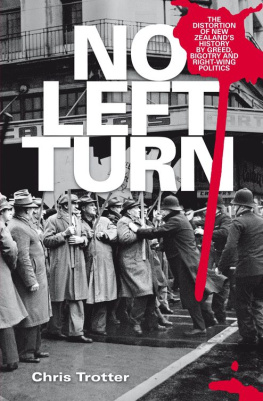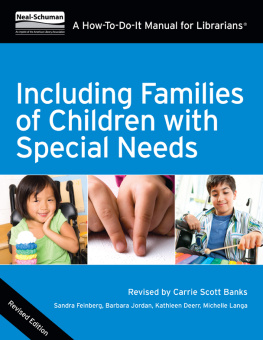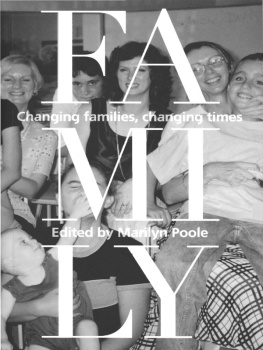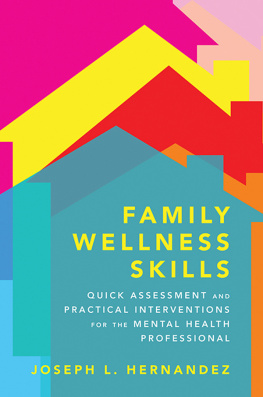First published 2013 by Allen & Unwin
Published 2020 by Routledge
2 Park Square, Milton Park, Abingdon, Oxon OX14 4RN
605 Third Avenue, New York, NY 10017
Routledge is an imprint of the Taylor & Francis Group, an informa business
Copyright Chris Trotter 2013
All rights reserved. No part of this book may be reprinted or reproduced or utilised in any form or by any electronic, mechanical, or other means, now known or hereafter invented, including photocopying and recording, or in any information storage or retrieval system, without permission in writing from the publishers.
Notice:
Product or corporate names may be trademarks or registered trademarks, and are used only for identification and explanation without intent to infringe.
Cataloguing-in-Publication details are available from the National Library of Australia
www.trove.nla.gov.au
Set in 12/14.5pt Bembo by Post Pre-press Group, Australia
ISBN-13: 9781741758320 (pbk)
Many people have influenced the development of Collaborative Family Work. The book owes much to the ideas of the late William Reid on family problem-solving and task-centred casework and to the work of the late Don Andrews on pro-social modelling and other skills. I am particularly indebted to the human service professionals who have helped to develop the Collaborative Family Work model over the past 20 years. I make particular mention of Loretta Allen Weinstein, Leonie Bender and the staff of Youth Justice in the Western Region New South Wales, Jane Christmas and Brian Heath from the probation service in the channel island of Jersey and Cath Powell, Charlene Periera and Matt Currie from the GRIPP program in the Dandenong Children's Court. Thanks go to Michael Clanchy who commented on an early draft of the book, Susie Costello and the reviewers who provided valuable comments on a later draft, and Lizzy Walton and Elizabeth Weiss from Allen & Unwin, who waited patiently for the book to be finished. Thanks to the editors Ann Lennox and Susan Jarvis and to Louise Oliaro and Tamara Thornton for their contribution to the case study transcripts. Thanks also to my department and colleagues at Monash University who allowed me the time to write. Finally, thank you to Joan and my family for their ongoing support.
For seminars on Collaborative Family Work, contact: christopher.trotter@monash.edu.
Sylvia works as a youth justice worker. She supervises young people who are placed on probation. Steve is 14 years old, and is one of her clients. He is on probation for stealing cars. He also has a problem with sniffing glue. Sylvia has worked with Steve for three months since he was placed on probation and has come to know him well. He has a long history of stealing cars and is due to return to court next week to face charges for another offence. He has a very poor record of school attendance and is pretty much illiterate. He has no real friends and most of his acquaintances are also school truants.
He lives with his father, Mario, his father's partner, Maria, and her two children, Emily, 14, and Jane, 11. Steve's mother died when he was 4 years old. He likes his father's partner but feels that she favours her own two children. Steve and his father don't get on well They rarely talk to each other and Steve feels that his father does not like him. Sylvia has interviewed Mario on several occasions and she feels that his rejecting and authoritarian attitude to Steve is an important factor in Steve's behaviour. In fact, it is her view that one of the reasons why Steve steals cars is to get his father's attention. On several occasions after police have visited the house, Mario has told Steve to get out of the house and not come back. This has been followed by Steve getting into further trouble. On one occasion after he was told to leave, Steve broke into a house with some other young people and stole money and food.
Sylvia feels that Mario cares about Steve but does not know how to deal with his behaviourharsh discipline is the only way he knows. Mario has acknowledged to Sylvia that it isn't working, but says that he can think of no other way of handling the situation. Steve talks about his father as if he is in awe of him. He talks about his father's work as a supervisor in an engineering shop that repairs ambulances. The ambulances must be maintained in perfect condition and only top-class mechanics can work in this field. He also talks about the times his father took him to the football, to the beach and so on.
Sylvia feels that she has done about as much as she can for this family. She has talked to Steve at length and she has talked to Mario and tried to persuade him to be more positive with Steve, and (to try) to let him know that he cares about him. She has even talked to Maria and asked her to encourage Mario to be more positive towards Steve. She feels that if she could get the relevant family members togethermaybe Steve, Mario and Maria, or even just Steve and Marioshe could work through the issues more effectively. However, she feels
that she does not have the skills or the confidence to work together with the family members to address the issues they are facing.
The aim of this book is to help professional workers like Sylvia to develop the skills and confidence to do this.
Andrea is a foster care worker. Sophia is 12 and has been in kinship foster care with her aunt, Stephanie, and Stephanie's partner, Huang, for three years. Sophia had been in several foster care placements before this; she had been happy with Stephanie and Huang until everything started to go downhill a few months ago. Stephanie rang Andrea, saying that things had deteriorated so much that they could no longer continue to foster Sophia. Her temper tantrums made them scared and they felt it was only a matter of time before she turned violent. They were also worried that their other two children were beginning to dislike Sophia. Andrea was very disappointed with the foster parents' attitude, mostly because it would be so difficult to place Sophia with another family. Sophia's mother was not an optionwhile she had some contact with Sophia, she continued to struggle with a mental illness and was not in a position to have her daughter with her. Earlier attempts to place Sophia with other relatives had failed.
Andrea understood the reluctance of the foster parents to keep Sophia with them; however, she could see that a move at this stage was not in Sophia's best interests, and she was worried that she would ultimately end up homeless. Andrea attempted to do some mediation with the three of them. She even tried involving Naomi, Stephanie's 16-year-old daughter. However, this did not seem to help and Andrea felt that she did not really know how to tackle working with the family group.









